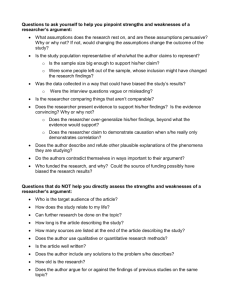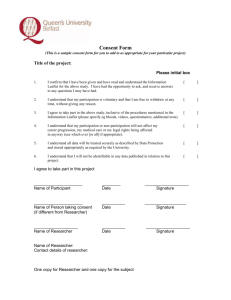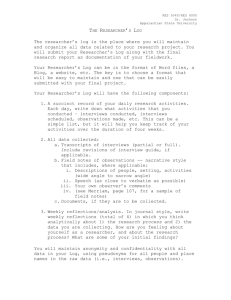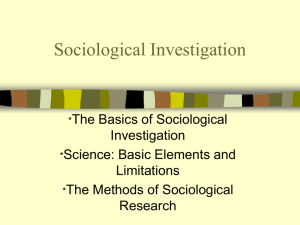Sociological Research
advertisement
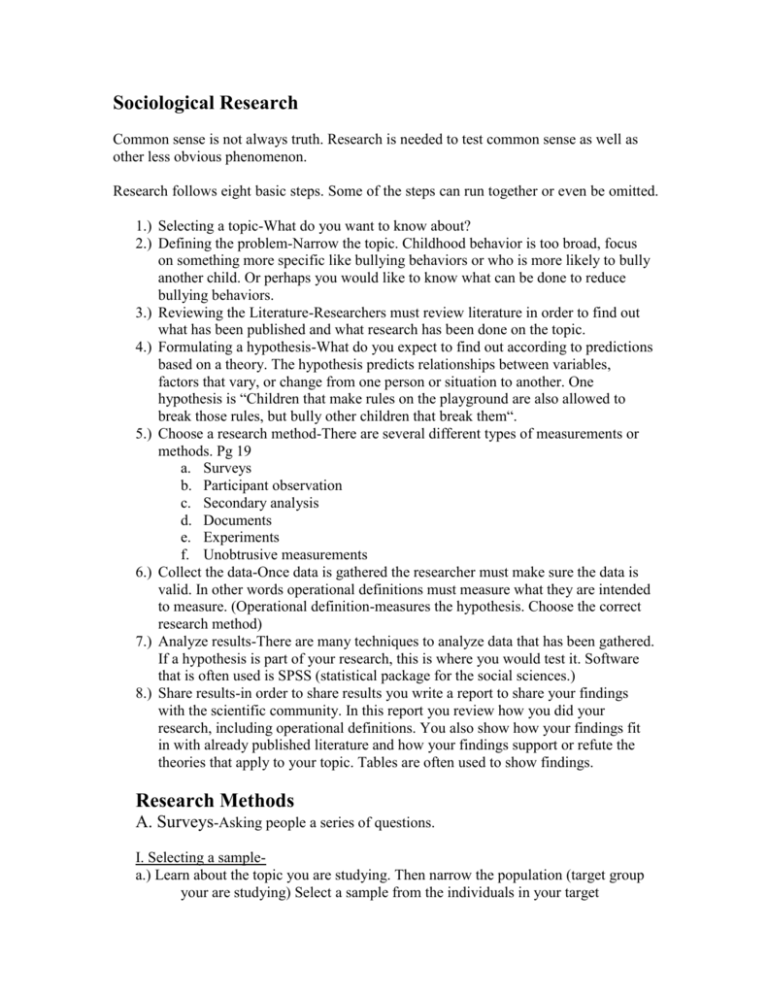
Sociological Research Common sense is not always truth. Research is needed to test common sense as well as other less obvious phenomenon. Research follows eight basic steps. Some of the steps can run together or even be omitted. 1.) Selecting a topic-What do you want to know about? 2.) Defining the problem-Narrow the topic. Childhood behavior is too broad, focus on something more specific like bullying behaviors or who is more likely to bully another child. Or perhaps you would like to know what can be done to reduce bullying behaviors. 3.) Reviewing the Literature-Researchers must review literature in order to find out what has been published and what research has been done on the topic. 4.) Formulating a hypothesis-What do you expect to find out according to predictions based on a theory. The hypothesis predicts relationships between variables, factors that vary, or change from one person or situation to another. One hypothesis is “Children that make rules on the playground are also allowed to break those rules, but bully other children that break them“. 5.) Choose a research method-There are several different types of measurements or methods. Pg 19 a. Surveys b. Participant observation c. Secondary analysis d. Documents e. Experiments f. Unobtrusive measurements 6.) Collect the data-Once data is gathered the researcher must make sure the data is valid. In other words operational definitions must measure what they are intended to measure. (Operational definition-measures the hypothesis. Choose the correct research method) 7.) Analyze results-There are many techniques to analyze data that has been gathered. If a hypothesis is part of your research, this is where you would test it. Software that is often used is SPSS (statistical package for the social sciences.) 8.) Share results-in order to share results you write a report to share your findings with the scientific community. In this report you review how you did your research, including operational definitions. You also show how your findings fit in with already published literature and how your findings support or refute the theories that apply to your topic. Tables are often used to show findings. Research Methods A. Surveys-Asking people a series of questions. I. Selecting a samplea.) Learn about the topic you are studying. Then narrow the population (target group your are studying) Select a sample from the individuals in your target population. This is an important factor in your study. The individuals you choose will affect the results of your study. If you only select educated women you will have skewed results. You want to generalize the findings to have a representative sample of your population. How do you do this? b.) The best way to get a generalized and representative sample is to get a random sample. In a random sample everyone in your population has the same chance to be included in your study. In order to get a random study you must… 1.) List everyone that fits your criteria 2.) Assign a number to everyone in your list. 3.) Using A table of random numbers, determine which of these women become part of your sample. (Random numbers are available on tables in statistics books or can be generated by a computer.) c.) Asking neutral questions-Once your population and sample is chosen, you need to make sure that the questions you will be asking are neutral. They must allow respondents (the people that respond to your survey) to express their own opinions. You do not want biased answers. Example on page 22. d.) Types of questions-You need to decide on open or closed-ended questions -Closed-ended questions are followed by a list of possible answers. These questions are good for ages, or marital status. -Open ended questions-allow people to answer questions in their own words. It is difficult to compare answers of open ended questions. One example of this is on page 24. e.) Establishing Rapport-Rapport is a feeling of trust between the researcher and the respondents. Once rapport is established respondents will typically talk about personal and sensitive matters. B. Participant ObservationAlso known as fieldwork is where the researcher participates in a research setting and observes what happens in that setting. (Homelessness) With good rapport, you may be able to spend time with participants in settings other that allow the researcher to see other aspects of the participants life. This may help the researcher understand how Homelessness has affected their life. This may give the researcher insight into how to improve the life of those living homeless. C. Secondary AnalysisWhen a researcher uses data that someone else has already collected. D. DocumentsWritten sources like books, newspaper, bank records, immigration files. To study spousal abuse a researcher might examine police reports and court records to find out who was charged, convicted or put on probation. Researchers may also be interested on the victims. Crisis intervention centers may have records on key information like diaries or notes on counseling sessions. E. ExperimentsUseful for determining cause and effect. 1.) The first thing that needs to be done is find individuals with similar backgrounds and characteristics. 2.) Separate the participants into two groups a. Experimental group-the group that will receive some sort of therapy or treatment. b. Control group-is the group that receives nothing. 3.) You also need to define both independent and dependent variables a. Independent variable-is something that causes a change in another variable. b. Dependent variable-is something that may change (How marriage changes men’s or women’s behaviors) 4.) If there is no difference between the two groups after one receives therapy you would be able to say that the therapy did not work and it was ineffective. If there was a difference between the groups you would need to find out if the therapy helped to change the behavior in a positive or negative way. The example in the book is therapy with men that are abusive to their spouses. If the men changed and stopped abusing their wife, then the therapy was successful. If the men started beating their wife on a more regular basis the therapy backfired. F. Unobtrusive MeasuresObserving behaviors of individuals that do not know that they are being studied. Ethics in Sociological Research Ethics in sociological research center on assumptions of science and morality. Ethics require several things. Among them are openness (sharing findings with the scientific community), honesty, and truth. Falsification of results and plagiarism are condemned and subjects should generally be informed that they are being studied. In addition, subjects should not be harmed and the anonymity of people providing private information should be held. A. Protecting SubjectsOne example of a researcher protecting the anonymity of his subjects was Mario Brajuha. Grad student that was a waiter and had interviewed several individuals at the resturaunt before it was burnt down. He was ordered to hand over his notes to the DA and he refused, then some unsavory individuals found out about the notes and also demanded them, but in a different mannor than the DA. A. Misleading Subjects: The Humphreys ResearchIt is often frowned upon for sociologists to misrepresent themselves. Laud Humphreys was an Episcopal priest that decided to become a sociologist. For his dissertation Humphreys studied social interation in “tearooms,” public restrooms where some men go for quick, anonymous sex with other men. Humpreys became a “watchqueen” an individual that watches out for police and other unwelcome individuals. Humphrey became interested in these individuals. Many wore wedding bands. He decided to write down license plates of these men. A friend of his in the police department gave him the addresses of the men. He then arranged for the men to participate in a medical survey and he dressed in disguise and interviewed these men for the medical study. He found that these men lead regular lives. Many of the men’s wives were afraid of becoming pregnant because their religion did not allow the use of birth control and many of the wives were also not aroused sexually. Was this research ethical?




